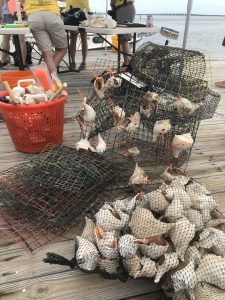Helping oysters recover in Barnegat Bay through our crab pot recycling program
by Emily Heiser
 Last week, Conserve Wildlife joined the American Littoral Society at their annual Parade of Boats event in conjunction with the Operation Oyster program.
Last week, Conserve Wildlife joined the American Littoral Society at their annual Parade of Boats event in conjunction with the Operation Oyster program.
Conserve Wildlife, through funding from NOAA’s Marine Debris Program, has spent the last several years in a related effort to clean up Barnegat Bay. Removing derelict crab traps or ghost pots from the bay has been an ongoing initiative. Ghost pots are lost in a variety of ways including improper rigging to buoys and buoy lines cut by passing boat traffic.
The issue spans not only the commercial crabbing industry, but the recreational industry as well. The longer the pots sit on the bottom of the bay the more likely they are to serve as a deathtrap for a variety of marine species. The more marine life that becomes trapped the more the pots continue to attract other marine life. This is of particular concern for Northern Diamondback Terrapins that frequently investigate these pots looking for a quick meal only to be trapped and quickly drown.
The project aims at a concept we are all quite familiar with – reduce, reuse, recycle. Through the help of local fishermen and several partners, we have reduced the number of pots in the bay by retrieving them and bringing awareness to the issue through public outreach.
The majority of the retrieved pots are recycled through National Fish & Wildlife Foundation and Covanta’s Fishing for Energy Program. The pots are taken to Covanta’s facilities where they are stripped of their recyclable metal and turned into combustible energy that can power up to 10,000 homes.
Finally, through the help of our partnership with the American Littoral Society, some of the pots are now being reused through Operation Oyster. Oysters play a vital role in the health and wealth of Barnegat Bay. One oyster can filter up to 50 gallons of water per day! Additionally, the oyster industry in New Jersey alone contributes over seven million dollars to the local economy each year.

The reused and repurposed pieces of the pots have now been turned into Whelk-come mats for oyster spat. The Whelk-come mats consist of a Ghost Pot’s panel and have been fitted with whelk shells that serve as the structure for oyster spat to grow on. The Whelk-come mats have been placed in three different locations and will be monitored through ALS and Stockton University to compare growth rates of the mats versus whelk shell reefs.
We are thrilled to continue our efforts in cleaning up Barnegat Bay! What was once something that took life from the bay now brings new life to it!
For more about our project, click here.
For a Press of Atlantic City story about this event, click here.
Discover more from Conserve Wildlife Foundation of NJ
Subscribe to get the latest posts sent to your email.
Leave a Comment
What a super use and re-use of resources! The Whelk-come mats are so creative!! Congrats to all for your efforts to clean up the bay!
Comments are closed.